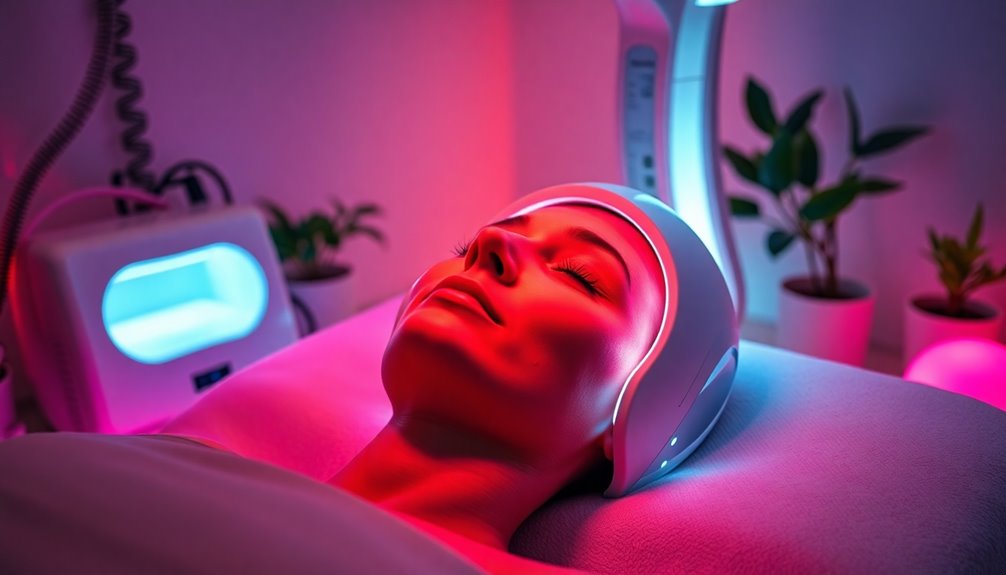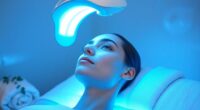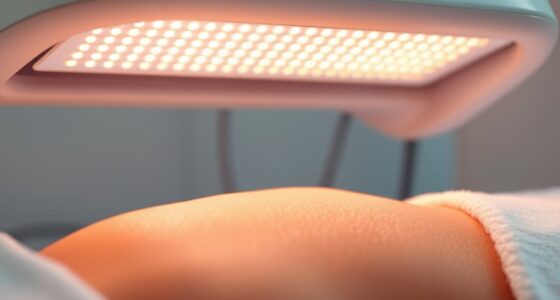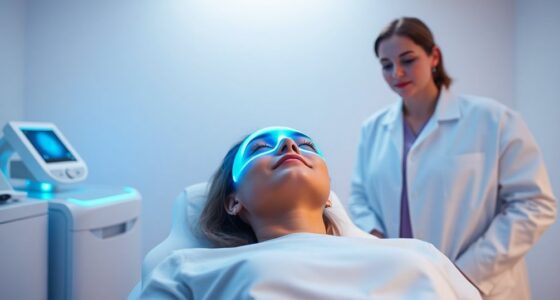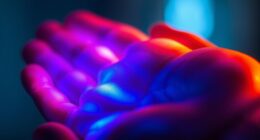LED light therapy dates back to ancient civilizations using sunlight for healing. By the 1980s, NASA's research revealed LED lights' potential for skin treatments, primarily targeting acne and promoting healing. Over the years, this therapy expanded to benefit issues like sun damage and hyperpigmentation. At-home devices emerged in the early 2000s, becoming more affordable and effective. Today, you can access improved technology that enhances various skincare routines. As you uncover this innovative treatment's evolution, you'll discover how it reshaped skincare and what the future holds for LED advancements.
Key Takeaways
- Ancient civilizations used sunlight for healing, with notable practices in Egypt and India treating skin conditions like leucoderma.
- NASA's 1980s research pioneered LED light therapy's application in skincare, originally intended for plant growth.
- Blue light effectively targets acne bacteria, while red light enhances healing and collagen production for anti-aging benefits.
- The development of at-home LED devices began in the early 2000s, making skincare treatments more accessible to consumers.
- Continuous advancements in technology and research are driving LED therapy's growth and significance in the skincare industry.
Early Beginnings of Light Therapy

Light therapy has roots that stretch back to ancient civilizations, where natural sunlight was harnessed for healing purposes.
In ancient Egypt and India, sunlight was used to treat leucoderma, showcasing its therapeutic potential.
Fast forward to the 1850s, and Florence Nightingale advocated for sunlight and clean air as vital for health restoration.
Then, in 1877, Downes and Blunt conducted an experiment demonstrating sunlight's ability to inhibit fungal growth, laying the groundwork for light therapy's development.
These early practices formed a crucial part of medical history, highlighting how ancient beliefs evolved into more structured approaches. The introduction of LED therapy in the 1980s marked a significant advancement in the application of light for treating various skin conditions.
As you explore the journey of light therapy, you'll see how these foundational ideas shaped modern treatments, paving the way for advancements we benefit from today.
Development of Acne Treatments
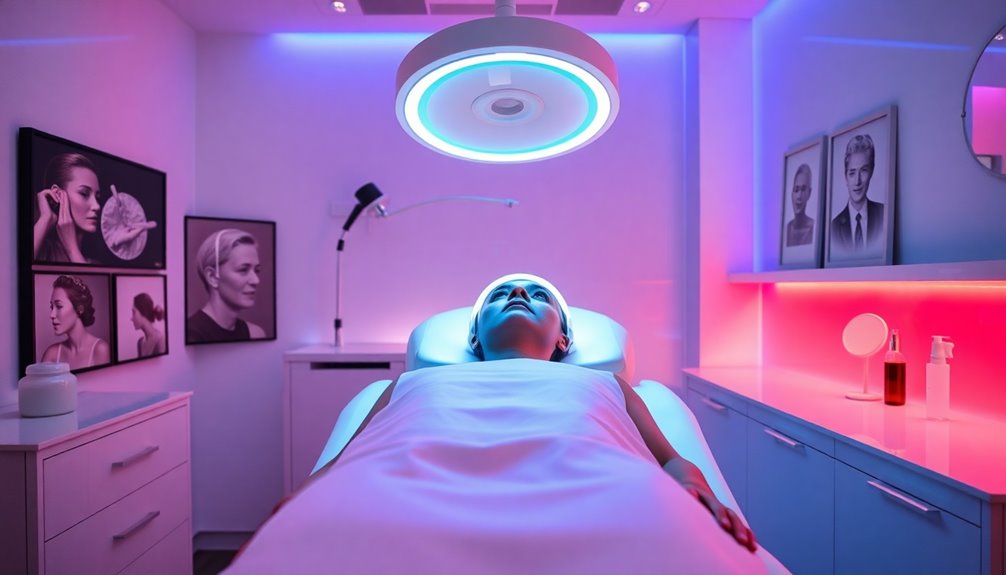
As researchers explored innovative ways to combat acne, the 1980s marked a significant turning point with the introduction of LED light therapy. Initially used by NASA for plant growth, these lights soon found their way into skincare.
Early studies highlighted blue light's antibacterial properties, targeting acne-causing bacteria effectively. By the 1990s, LED therapy evolved to include skin rejuvenation and acne management.
Blue light inhibits sebocyte proliferation and reduces sebum production, while red light promotes healing and reduces inflammation. In clinical trials, combining these lights showed promising results for mild-to-moderate acne. Recent advancements have demonstrated that LED therapy's effectiveness extends beyond acne treatment, assisting in skin healing and overall texture improvement.
This non-invasive treatment is safe for all skin types, requiring few precautions, making it an attractive option for those struggling with acne. Regular maintenance treatments help sustain results.
Expansion to Wider Applications
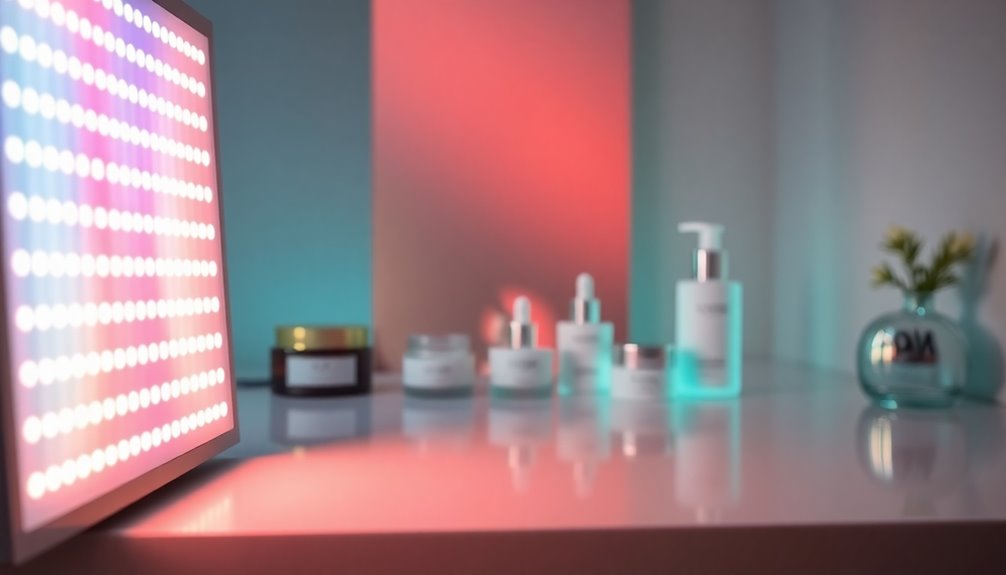
The evolution of LED light therapy has opened doors to a broader range of skincare applications beyond just acne treatment.
Initially confined to professional settings, these treatments have become accessible for at-home use, thanks to advancements in technology. NASA's initial focus on photosynthesis has significantly influenced the understanding of how specific wavelengths can benefit human skin.
Now, you can find portable, affordable devices that cater to various skin concerns.
The growing consumer awareness around LED therapy has driven significant market growth, with the global LED light face mask market valued at over USD 238 million in 2021.
Moreover, the medical community increasingly recognizes its benefits, supported by clinical trials that confirm its efficacy.
Researchers are also exploring new applications, including customizable wavelengths and combination therapies, expanding the possibilities for healthier skin.
Key Skin Benefits of LED
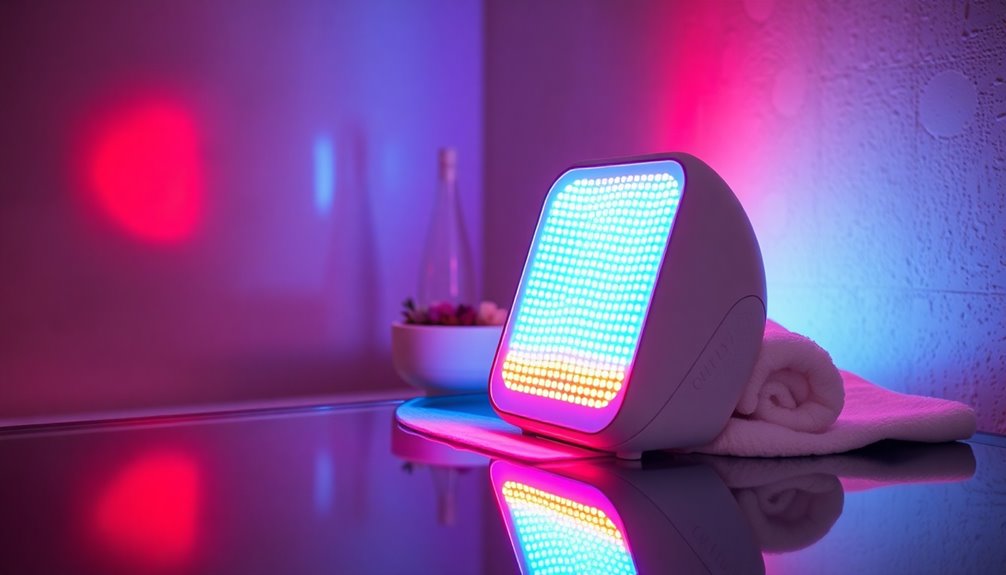
Harnessing the power of LED therapy brings a multitude of skin benefits that can transform your skincare routine.
If you're battling acne, blue light effectively kills acne-causing bacteria while red light reduces inflammation and redness, helping to clear breakouts. This treatment is particularly effective for individuals with severe acne and acne-prone skin.
For anti-aging, red light stimulates collagen production, smoothing fine lines and enhancing skin elasticity. It also improves your skincare product absorption, maximizing their effects.
When it comes to wound healing, red LED light accelerates tissue repair, while yellow light boosts detoxification.
Plus, LED therapy rejuvenates sun-damaged skin, reduces hyperpigmentation, and enhances overall radiance.
With its non-invasive nature, LED therapy offers a safe and effective solution for various skin concerns, making it a must-try in your routine.
Treatment Settings and Environments
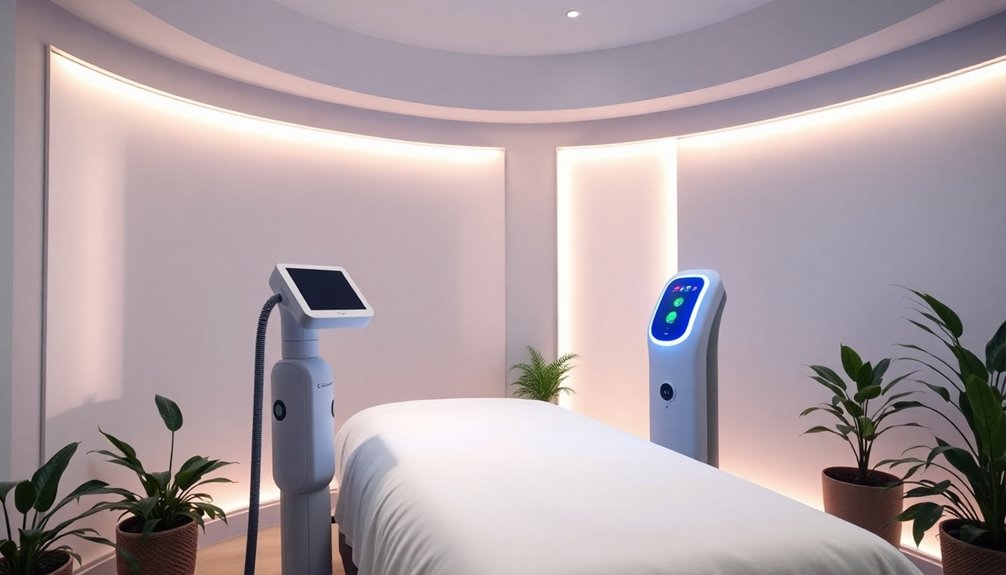
When considering LED light therapy, understanding the treatment settings and environments is crucial for achieving the best results.
Position the device 30-45 cm from your skin for anti-aging benefits, or 15-30 cm for targeted issues like wound healing. Ensure the LEDs are about 2.5 inches from your skin for optimal effect. The importance of a clean slate before treatment cannot be overstated, as it ensures effective light penetration and maximizes treatment efficacy.
Start with sessions lasting 1 to 10 minutes, increasing to 20 minutes as your skin adjusts. Cleanse and, if desired, exfoliate your skin before treatment. Remember to wait at least 24 hours between sessions to let your skin recover.
Choose the right device for your needs—portable units for specific areas or LED beds for full-body treatments—ensuring you follow the user manual for best outcomes.
Safety and Effectiveness Overview
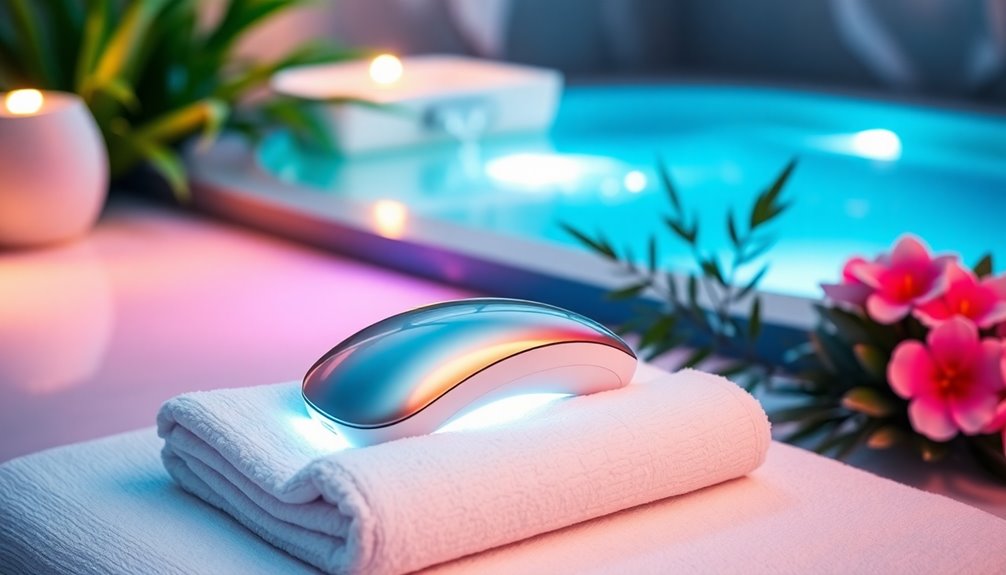
Understanding the treatment settings and environments for LED light therapy sets the stage for its safety and effectiveness. Different treatment settings, such as professional clinics and at-home devices, can significantly influence the outcomes of LED light therapy. By closely examining these environments, practitioners can tailor the therapy to fit individual needs, maximizing its benefits. In addition, many fans of the treatment have sought inspiration from celebrity skincare routines, leading to an increased interest in exploring techniques like bella hadid’s skincare secrets.
LED light therapy is safe for regular use since it doesn't contain UV rays and is compatible with all skin colors. However, avoid this treatment if you're on Accutane or have skin rashes. While rare, some side effects like temporary redness or allergic reactions can occur, so patch testing is recommended. The therapy excels in anti-aging and acne treatment, especially when combining red and blue light. Professional treatments typically yield more pronounced results compared to at-home devices, making them a valuable option for those seeking effective outcomes.
For optimal results, professional treatments are more effective than at-home devices. Always wear eye protection and consult a dermatologist to assess your unique needs and risks before starting treatment.
Common Applications in Skincare
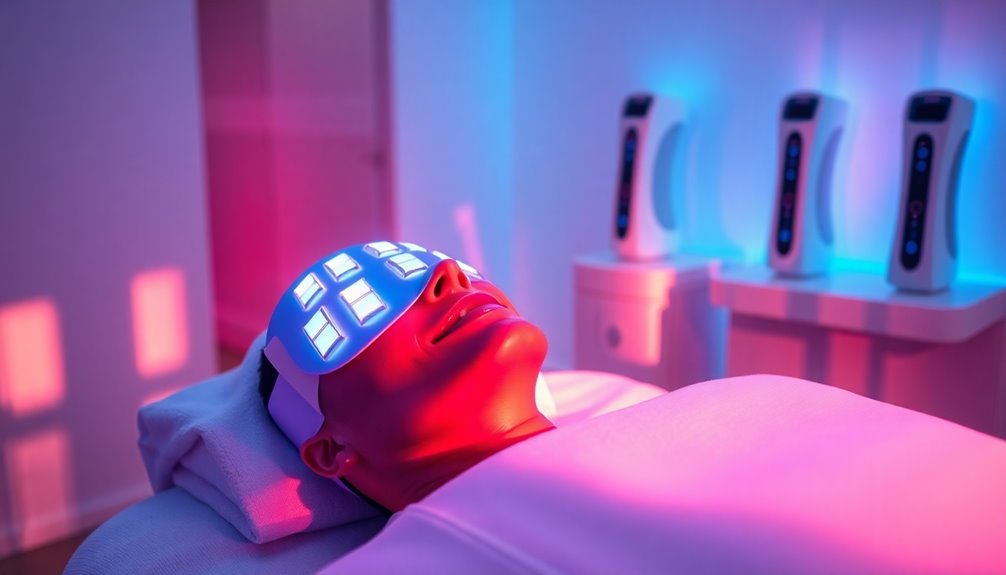
How can LED light therapy transform your skincare routine? This innovative treatment offers targeted solutions for various skin concerns.
For acne, blue light therapy effectively eliminates acne-causing bacteria, while red light reduces inflammation and sebum production. Many find success with combination therapy, which enhances results.
When it comes to anti-aging, red and near-infrared light stimulate collagen and elastin production, leading to firmer skin and reduced fine lines. Research shows that different wavelengths can penetrate the skin at various depths to yield specific benefits.
If you're dealing with psoriasis, red and near-infrared light can alleviate redness and inflammation.
While at-home devices provide convenience, regular treatments yield the best results. For serious conditions like skin cancer, professional photodynamic therapy is essential.
Embracing LED light therapy can significantly elevate your skincare game.
Breakthroughs in Research and Technology
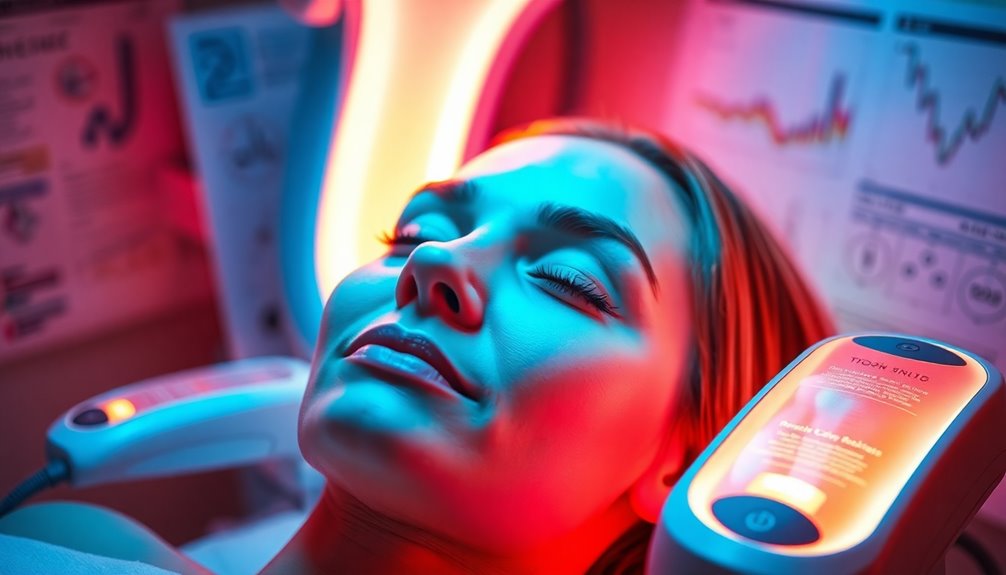
As advancements in LED light therapy continue to unfold, the potential for transforming skincare routines becomes increasingly evident.
Early discoveries from NASA highlighted the healing power of LED lights, revealing their ability to stimulate cellular processes and enhance mitochondrial function. Groundbreaking studies confirmed the effectiveness of specific wavelengths for treating conditions like acne, herpes simplex, and wound healing. Additionally, clinical studies have shown significant improvements in skin clarity and texture, further validating the efficacy of this innovative therapy.
Technological advancements have further refined these therapies, introducing improved luminosity and targeted treatments. Integration with AI allows for personalized protocols tailored to your skin type and needs, while portable devices like LED masks offer convenience.
Ongoing research promises even more innovative applications, ensuring LED therapy remains at the forefront of skincare advancements.
Evolution of At-Home Devices

While the evolution of at-home LED light therapy devices has transformed skincare routines, it began with limited options and high costs.
In the 1980s, LED therapy was primarily for acne, and consumer devices were scarce. It wasn't until the early 2000s that the first at-home devices emerged, mainly targeting skin rejuvenation.
Initially, these devices were expensive and less effective than professional treatments. However, by the mid-2000s, prices dropped, making them accessible to more people.
A variety of options, such as masks and handheld units, became available. With advancements in technology, modern devices now offer improved wavelengths and user-friendly designs, catering to diverse needs while ensuring safety and effectiveness. Additionally, the continuous evolution of niche treatment has made LED therapy a staple in many skincare routines.
Future Trends in LED Therapy

What exciting innovations lie ahead for LED therapy in skincare? You can expect advancements in device technology, including improved wavelength customization and enhanced power for quicker, more effective treatments.
Wearable devices are emerging, offering continuous light therapy that fits seamlessly into your routine. Plus, miniaturized, portable options make it even easier to use. Recent breakthroughs have revealed new applications in health and wellness, showcasing the potential for enhancing overall skin rejuvenation.
Combination therapies will also take center stage. Pairing LED therapy with chemical peels or injectables can amplify results, while customizable treatment plans address multiple skin concerns.
Research continues to explore new wavelengths and targeted applications, expanding LED therapy's reach into various dermatological conditions. As awareness grows, affordable at-home devices will empower you to harness these benefits conveniently and effectively.
Frequently Asked Questions
How Does LED Therapy Differ From Traditional Light Therapy?
LED therapy differs from traditional light therapy primarily in light source and intensity.
You'll find that LED uses low-level light-emitting diodes, while traditional methods often rely on concentrated lasers.
LEDs can treat larger areas safely and penetrate skin at varying depths, targeting different skin concerns.
Additionally, LED therapy is non-invasive and suitable for all skin types, whereas traditional therapies can be more invasive and carry higher risks if not performed by professionals.
What Skin Types Are Best Suited for LED Treatments?
Imagine your skin like a garden; each type needs different care. LED treatments are versatile, making them ideal for all skin types.
If you've got oily skin, blue light zaps acne-causing bacteria. For dry skin, red light boosts hydration and collagen.
Combination skin benefits from both, balancing oil and enhancing product absorption. Even sensitive skin finds relief with red light's soothing properties.
Are There Any Side Effects of LED Light Therapy?
Yes, there are some side effects of LED light therapy.
You might experience temporary redness or irritation due to increased blood flow, which usually fades within hours.
Mild dryness and peeling can occur from enhanced cellular turnover, so hydration is key.
Additionally, your skin may become more sensitive to sunlight, making sunscreen essential.
It's wise to patch test for allergies and consult a dermatologist if you notice severe irritation or other unusual reactions.
How Long Does a Typical LED Therapy Session Last?
A typical LED therapy session lasts between 10 to 20 minutes, depending on your specific needs and the device you're using.
For example, if you're using a red light LED face mask, aim for sessions of 10 to 30 minutes, two to three times a week.
It's essential to find a routine that works for you, ensuring you don't overexpose your skin while maximizing the benefits of the therapy.
Can LED Therapy Be Combined With Other Skincare Treatments?
Absolutely, you can combine LED therapy with other skincare treatments!
In fact, doing so enhances the overall effectiveness of your regimen. LED light boosts your skin's receptivity, improving product absorption and collagen production.
Whether you're pairing it with chemical peels, microdermabrasion, or microneedling, you'll notice quicker healing and reduced downtime.
This combination addresses multiple skin concerns, giving you a comprehensive approach to rejuvenation that can lead to visible, radiant results.
Conclusion
In the ever-evolving world of skincare, LED light therapy stands out as a beacon of hope. You've seen how its journey—from early experiments to cutting-edge at-home devices—has transformed the way we approach skin health. Isn't it remarkable how a simple light can unlock a treasure trove of benefits? As you explore this innovative treatment, remember that the future of skincare is bright, and LED therapy is leading the charge toward radiant, healthier skin.
